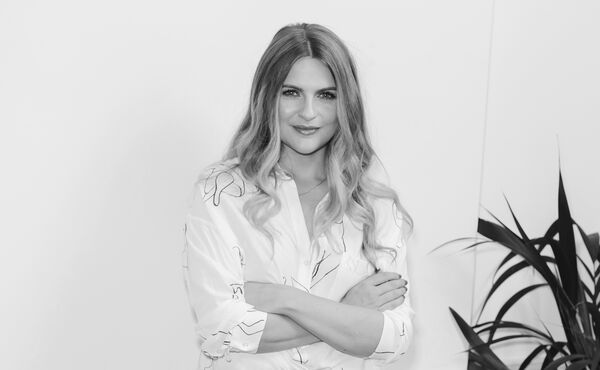Sound healing is one of the hottest wellbeing trends right now, credited with countless benefits from reducing anxiety to improving sleep. Here’s why you should tune in
Across the globe from LA to London, more and more people are reaping the benefits of ‘sound healing’. From group sound bath sessions, where a therapist uses ancient instruments such as Tibetan bowls, gongs and rainmakers, to digital playlists said to quickly calm a stressed out brain, the wellness crowd are increasingly tuning in to the fact that it’s not just what you do with your body (hello, yoga), or feed it (green smoothie, check), but what stimulates it that can impact your wellbeing. And no wonder – increasing amounts of research claim that ‘sound healing’ benefits everything from anxiety, to sleep and even physical pain. Oprah called sound baths “wonderful, calming, relaxing,” while audio giants Bose recently launched earplugs that link to sleep-promoting tracks via an app.
“Whether you’re receiving sound healing in a live session or digitally, you will feel the benefits from it,” says Farzana Ali, also known as The Sound Therapist. For some, sound healing can be life altering. “I’ve seen clients who have completely overhauled their lives after building up a regular practice,” says Farzana. “Helping them to address self-limiting beliefs, and learn to manage their daily lives with less stress. I had one client who looked like a new person after just four weeks. Her body language changed, she started sleeping better, her entire attitude to life was transformed.”
How is sound a healer?
Sound occurs when an object vibrates and transmits energy through the air reaching our ear drums that then vibrates. From here, a signal is sent to the brain that recognises it as sound. Because our bodies are made up of 75% water and water is a brilliant conductor for sound vibration, sounds can help relax our muscles and boost lymphatic flow leading to lower stress levels and improved sleep. No wonder those chilled Ibiza mixes make us feel so Zen.

What is sound healing?
Perhaps one of the attractions is that this form of wellbeing is fairly low effort. The most strenuous form is attending an organised sound bath, but in its easiest form you simply need to pop in your earbuds and listen to an audio track. There are plenty of different types of sound and each has its own benefits that have been woven into our exclusive soundscapes (more on those below).
Solfeggio frequencies can be found in nature, such as the buzzing of a bee. “With Solfeggio frequencies, the idea is that certain tones impact certain parts of the body to promote healing,” notes Farzana.
Binaural beats are different frequencies played into the left and right ears. Once they reach the brain, the tones intertwine to form one beat with a new frequency. It is this frequency that was discovered to have physical and mental benefits, including enhanced sleeping cycles and reduced anxiety. With the exposure of 6Hz frequency of binaural beats specifically, in just 10 minutes the brain can stimulate a response similar to that of meditation. You can listen to binaural beats through headphones but Farzana can also create the effect in her live sessions. “The way different instruments are used - such as singing bowls, gongs, tuning forks - can create binaural beats so your brain perceives that different tone.”
Beyond Solfeggio frequencies and binaural beats, there is white, pink and brown noise that are worth having on your radar (and in your headphones).
White noise contains every frequency, and sounds similar to that of static noise such as an untuned radio or television. Psychotherapist Dr Gary Herrington explains how “it is helpful in noise cancelling, reducing input to the mind, allowing it to drift into a calmer state, which is why white noise machines are used for babies.”
“Pink noise is a softer version of white noise and doesn’t contain some of the higher frequency sounds,” explains Farzana. Think sounds like a waterfall or raindrops. Studies have shown how pink noise can enhance memory and cognitive performance and are best during moments of concentrated work.
Brown noise is on an even lower frequency than pink noise, sounding like a gentle rumble of thunder or waves crashing in the ocean. “It is quite useful for concentration and often favoured by neurodivergent brains,” notes Farzana.
As with many wellbeing trends, this one is steeped in history, with sound baths originating in ancient Tibet, while chanting was a form of meditation for 9th century Gregorian monks. And that’s the thing, for anyone who finds meditating difficult, sound healing can be a fast-track to a meditative state. “Sound has the power to change your most dominant brainwave state to take you to a place of feeling calmer,” says Farzana.
Rituals’ soundscapes
Created by Willem van Erven Dorens, an audiovisual artist focused on wellbeing and science, our collection of soundscapes help you to reach a meditative state. Each is inspired by one of the 13 themes that make up The Art of Soulful Living, from awareness and purpose to positivity and gratitude, the aim is to bring the themes to life and soundtrack your journey to personal wellbeing.
“Binaural beats play a big role in the Art of soulful living soundscape series,’ says Willem. “Binaural beats are two slightly different frequencies that together combine in our brain creating a new frequency. They are in a very low frequency range and can work on a low volume and on a subconscious level. If you want to feel more purposeful, mindful or positive, listening to binaural beats can help you enter in a certain state of mind, and the goal of these soundscapes is to help get you there.”
Through extensive research, Willem merged musical compositions with Solfeggio sounds, binaural beats, plus white, pink and brown noise to bring each theme to life. “I tried to make each soundscape as diverse as possible. Some have a musical foundation, like Compassion and Gratitude, with a piano and orchestral sound. Here the state of mind is influenced by certain chord progressions or musical theory. For Awareness and Authenticity the binaural beats stand central and are combined with less traditional instruments like digital and analog synthesisers. I used many natural sounds and environmental recordings to keep the listener grounded and in touch with ourselves because, after all, humans are part of nature.
There is another reason why nature sounds play a big part in the Rituals soundscapes – and why being on the countryside can be so relaxing. “Nature, in general, is well balanced,” says Willem. “If you were to record the sounds in your home, you would have a lot of low frequencies from equipment like your fridge and computer. This imbalance can affect you. In nature you will often find a more balanced spectrum. In the high and mid-range we find most animals from the low moooo of a cow to the high singing of birds. In the lower range we find things like wind and rivers, his balance is recognisable and creates a relaxing effect. This inspired the more calming soundscapes in the collection – that all-important balance of high and low frequencies.”
Music is of course subjective, but there are some sounds that are guaranteed to create reactions in humans. “Chord progressions play a big role in triggering a positive emotional response,” notes Willem. “While minor chords sound sad and remove energy, a fifth [combining two different pitches] is very uplifting and gives power and energy.”
These unique soundscapes help you tap into different emotions. “The compositions are communication tools, made to create a subconscious reaction,” explains Willem. “I want you to feel inspired and encouraged to look intuitively inwards, to connect to the different compass themes in The Art of Soulful Living.”
A sensory moment
To get the most out of each soundscape, Willem recommends that you wear headphones so that the different frequencies in each ear can create the new frequency that influences the brain for optimal results.
“Awareness is inspired by the earth waking up, with binaural beats that create a state of being aware, so it can be nice to listen to in the morning,” says Willem. During those afternoon slumps, Willem suggests listening to the “the Positivity or Purpose soundscapes to boost your energy, activating your brain for concentration and creativity”. In the evening, “the “Authenticity soundscape has the lowest frequency so, scientifically, that’s better to listen to at night when you want to relax.”
But really, there is no right or wrong time to listen to each soundscape “at any moment of the day you might want to feel a certain way,” notes Willem. Simply find what works for you and enjoy the immersive experience.
Dive deep into the endless wellbeing benefits of transformative sound with the Rituals soundscapes below.
About Willem van Erven Dorens:
After studying Sonology at The Royal Conservatoire of The Hague, Willem delved into experimental studies looking at the mathematics and physics behind ambient sound and music. Based in Amsterdam, he works as a freelance composer and sound designer.
-
View full details99,00 kr
-
View full details219,00 kr
-
View full details259,00 kr
-
View full details499,00 kr
.jpg?sw=1440&sh=445&sm=fit&cx=0&cy=0&cw=1440&ch=445&sfrm=jpg)






.jpg?sw=600&sh=370&sm=fit&cx=0&cy=0&cw=600&ch=370&sfrm=jpg)



